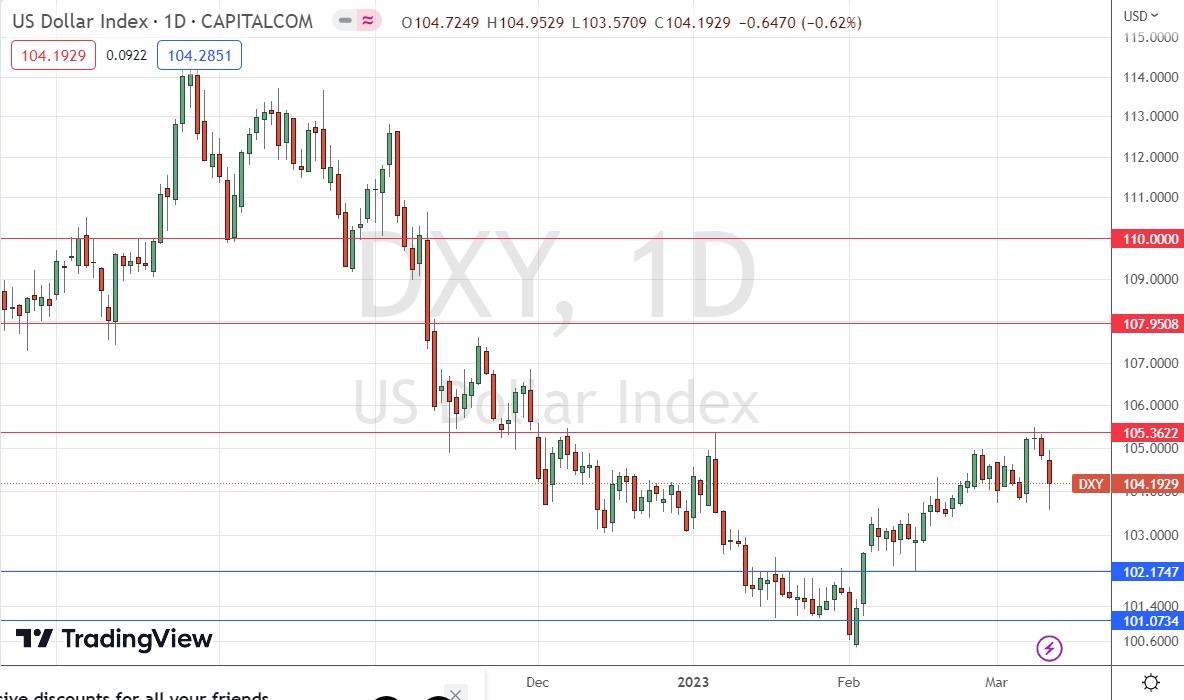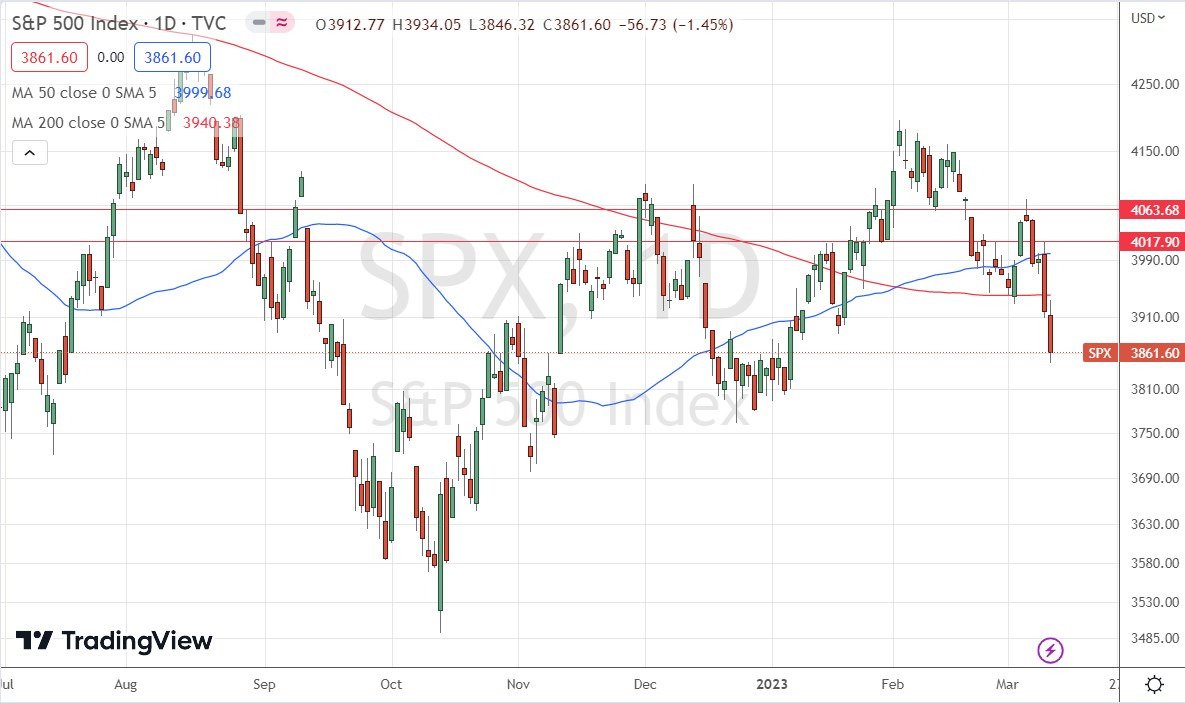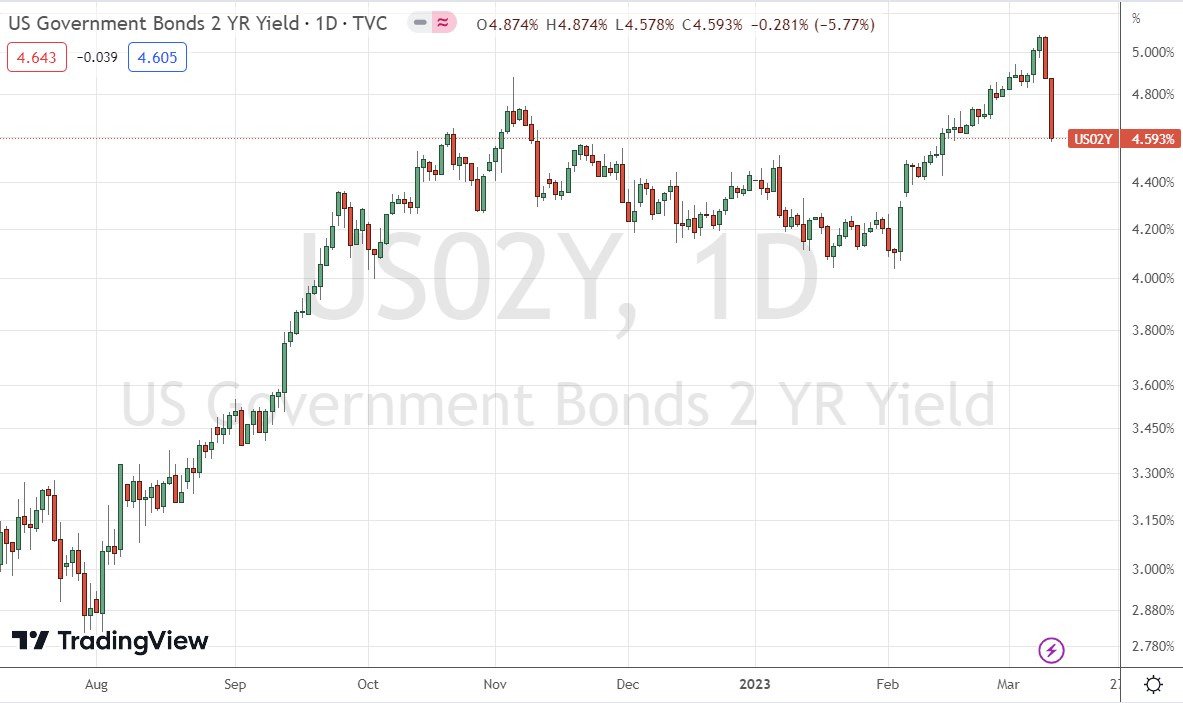[ad_1]
Fear of Bank contagion following the collapse of SVB, stronger-than-expected NFP data, and hawkish rhetoric from Fed Chair Jerome Powell have combined to sink stock markets and short-term US treasury yields.
The difference between success and failure in Forex / CFD trading is highly likely to depend mostly upon which assets you choose to trade each week and in which direction, and not on the exact methods you might use to determine trade entries and exits.
So, when starting the week, it is a good idea to look at the big picture of what is developing in the market as a whole, and how such developments and affected by macro fundamentals, technical factors, and market sentiment. There are just a very few valid long-term trends in the market right now, which might be exploited profitably. Read on to get my weekly analysis below.
I wrote in my previous piece on 5th March that the best trade opportunity for the week – the only one which set up given my conditions – was likely to be long of the US 2-Year Treasury Yield, which closed at a record high above 5% and finally saw its 50-day moving average cross above its 200-day moving average. Unfortunately, the collapse of Silicon Valley Bank saw this yield tank hard, producing a losing long trade.
The news is dominated by three major issues:
- The collapse of Silicon Valley Bank. Although deposit holders are expected to get their money bank, there are fears of contagion. Stock markets ended the week falling hard, with the S&P 500 Index making its lowest daily close in over 2 months, and banking shares hit particularly hard. The FDIC and the Fed are working hard to ring fence SVB and prevent contagion, but this fear is spooking the market. Markets also see the Fed as much less likely to hike rates as this would risk collapsing any other vulnerable banks, so on Friday we saw the unusual sight of the 2-Year Treasury Yield tanking just as hard as the stock market, simultaneously.
- Friday’s US non-farm payrolls data came in higher than expected, with 311k new jobs created last month when only 224k had been expected. However, the unemployment rate rose from 3.4% to 3.6%, and average hourly earnings increased by only 0.2% when an increase of 0.3% had been expected. Overall, if not for the fear of bank contagion, this news would probably have been a little bullish for the US Dollar.
- Last Tuesday saw Fed Chair Jerome Powell testify before the US Senate. His hawkish rhetoric on rates and inflation led to a leap in rate expectations, with many analysts seeing a terminal rate closer to 6%. This caused stocks to fall, and the 2-Year Treasury Yield rose, to a 15-year high above 5%.
It is very likely that Friday’s risk-off sentiment is going to continue until US Treasury Secretary Janet Yellen’s team has done enough to assuage fears of contagion within the banking sector. This is likely to be very negative for stock markets. Unusually, money is not obviously flowing into the US Dollar, so it will be risk-off without the usual Dollar inflow, which can make this a challenge to trade as flows are not obvious.
There were a few other significant data releases last week:
- Bank of Japan Monetary Policy Rate and Statement – there were no rate or policy changes, but retiring Governor Kuroda’s spirited defense of his ultra-loose policy saw the Yen fall somewhat.
- Bank of Canada Overnight Rate and Rate Statement – the Bank changed nothing and confidently predicted inflation will fall to 3% by the middle of this year. This was seen as dovish, and the Canadian Dollar fell following the release.
- Reserve Bank of Australia Cash Rate and Rate Statement – the RBA hiked rates by another 0.25% to 3.60%, expressing concerns inflation still too high and not falling fast enough, but laid out hope that time to pause hikes is drawing close.
- Swiss CPI (inflation) data – this came in higher than expected with a month-on-month increase of 0.7%, higher than the 0.5% which had been expected. This has hawkish implications and has probably boosted the value of the Swiss Franc, which rose firmly over the week.
- US JOLTS job openings data – this beat expectations, just as the non-farm payrolls data did later in the week.
- UK GDP data – this came in a little higher than expected, with a month-on-month increase of 0.3% compared to the 0.1% increase which had been forecasted.
- Canadian Unemployment data – this was a little better than expected, with the rate holding steady at 5.0% when a slight increase to 5.1% was forecasted.
The coming week in the markets is likely to see a higher level of volatility than last week, due to ongoing fear of bank contagion and the release of all-important US CPI (inflation) data. This week’s key releases are, in order of importance:
- US CPI (inflation) – this is expected to fall from an annualized rate of 6.4% to 6.0%.
- European Central Bank Main Refinancing Rate + Monetary Policy Statement
- US PPI
- US Retail Sales
- UK Budget
- US Preliminary UoM Consumer Sentiment
- US Empire State Manufacturing Index
- New Zealand GDP
- UK Claimant Count Change
- Australia Unemployment
The weekly price chart below shows the U.S. Dollar Index printed a bearish candlestick continuing the rejection of the key resistance level at 105.36.
The candlestick is quite large but has a substantial lower wick, suggesting neither bulls nor bears are decisively in control here. Another bearish sign is that the Dollar is again trading below its levels of both 3 and 6 months ago.
The US Dollar is likely to face conflicting pressures and high volatility over the coming week, due to fear of US bank contagion, but also the upcoming release of US CPI data. For the time being, trades against the US Dollar are most likely to be successful, but traders should follow the news closely and beware of volatility events.

The AUD/CHF currency cross is at the heart of the Forex market now, and for good reasons.
Markets are in risk-off mode due mostly to the collapse of Silicon Valley Bank and the accompanying fear of contagion to other banks, but also partly due to the US Federal Reserve’s warning last week on persistently high inflation.
Funds are looking for a safe haven, which is typically the US Dollar, but the Dollar cannot fulfil that function. Therefore, we are seeing a flow into the Swiss Franc to fulfil that role.
On the other hand, the Australian Dollar typically suffers under risk-off market conditions, and this is what we saw last week, with the Aussie falling strongly everywhere.
This currency cross fell very strongly last week, with both currencies showing more directional movement than any other major currencies, to reach a near 3-year low. We see strong bearish momentum here.
The situation could be volatile as the US Treasury is working hard to stop any bank contagion and may be successful, which could cause a big swing in the Forex market. Yet until that happens, being short of this currency cross is likely to be a good trade, due to the strong momentum and sentiment supporting it.
We saw a strong fall in the S&P 500 Index over the week and especially on Friday. Stock markets were initially rattled by Fed Chair Jerome Powell’s hawkish testimony before the Senate on Tuesday, before being even more strongly shaken by the collapse of Silicon Valley Bank, raising fears of contagion within the banking system.
The daily price chart still shows a valid golden cross (or bull cross), where the 50-day MA crosses over the 200-day MA, valid since almost four weeks ago. Such a cross historically indicates the beginning of a major bull move, so it could be a great long-term buy signal. However, it is important to note that during the last 50 years, no golden cross which sees a subsequent price fall of more than 7.3% has ever recovered to produce a profitable bull market trade, so I am calling an end to this nascent bull market.
Further bearish signs are the two consecutive daily closes below the 200-day moving average, and the reinforcement of a key resistance level just below 4018.
Much will now depend upon whether the US Treasury can restore faith that banking contagion will not spread. Until that is done, we are likely to see a further decline in the US stock market.

Short-term US Treasury Yields initially rose again last week, notably the 2-year yield, as Jerome Powell talked up rates and inflation, raising expectations for rate hikes. The 2-year yield began to trade at a new 15-year high above 5%. However, Thursday and Friday saw strong falls, with Friday’s massive drop being unusually large. In just three days, markets have moved from seeing near-term rates from above 5% to almost 4.5%.
This strong drop has been caused by the collapse of the Silicon Valley Bank, as the present fear of contagion within the banking system triggering the collapse of other banks will make further US rate hikes in the short-term impossible, until the contagion fear is removed.
I doubt this yield will fall by much more, but I don’t see it recovering unless the US Treasury produces a very impressive fix quickly.

I see an opportunity to be short of the AUD/CHF currency cross until the US Treasury gets a convincing handle on the Silicon Valley Bank situation.
Ready to trade our Forex weekly analysis? We’ve shortlisted the best Forex trading brokers in the industry for you.
[ad_2]
